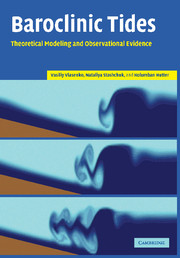Book contents
- Frontmatter
- Contents
- List of tables
- Preface
- Acknowledgements
- List of symbols
- List of abbreviations
- Preamble
- 1 General background
- 2 Linear baroclinic tides over variable bottom topography
- 3 Combined effect of horizontal density gradient and bottom topography on the dynamics of linear baroclinic tides
- 4 Topographic generation of nonlinear baroclinic tides
- 5 Evolutionary stages of baroclinic tides
- 6 Generation mechanism for different background conditions
- 7 Three-dimensional effects of baroclinic tides
- References
- Index
7 - Three-dimensional effects of baroclinic tides
Published online by Cambridge University Press: 14 August 2009
- Frontmatter
- Contents
- List of tables
- Preface
- Acknowledgements
- List of symbols
- List of abbreviations
- Preamble
- 1 General background
- 2 Linear baroclinic tides over variable bottom topography
- 3 Combined effect of horizontal density gradient and bottom topography on the dynamics of linear baroclinic tides
- 4 Topographic generation of nonlinear baroclinic tides
- 5 Evolutionary stages of baroclinic tides
- 6 Generation mechanism for different background conditions
- 7 Three-dimensional effects of baroclinic tides
- References
- Index
Summary
In the previous chapters we have only considered the two-dimensional nature of baroclinic tides. This simplification of the three-dimensional behavior is a valid approximation in shelf zones, at least as a tendency, due to the oblongness of the continental margins. It is, however, often violated when one tries to study the wave-generation process near three-dimensional bottom features like oceanic banks or abrupt changes of the shelf break topography in the along shore direction. Such places constitute a remarkable sink of barotropic tidal energy into baroclinic wave components if only a substantial along slope tidal flux interacts with along shore bottom variations. Under such conditions, the correct prediction of the total scattering of the barotropic tidal energy into internal tides is impossible without using three-dimensional global tidal models, which can predict the dynamics in those shelf areas where such a remarkable along slope forcing of internal tides may exist. Figure 7.1 illustrates this point. The broad gray bands show regions where the tide, derived from the barotropic model of Schwiderski [214], propagates along the coast as a Kelvin-type wave, and where the amplitude of its elevation is larger than 0.4 m. If the depth of the ocean near shore is estimated typically as 2000 m, then the value of the maximum barotropic tidal flux along the slope is of the order of 60 m2 s-1.
- Type
- Chapter
- Information
- Baroclinic TidesTheoretical Modeling and Observational Evidence, pp. 308 - 334Publisher: Cambridge University PressPrint publication year: 2005



